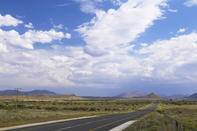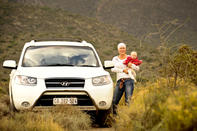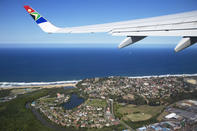Getting Around South Africa

Major South African cities are linked by reliable air, rail and road transport services. Public transport is used by many locals as a way of commuting to and from work.
Driving Around

Whether you’re looking entering one of the other countries in Southern Africa or self-driving to visit wildlife reserves, driving around in a car is relatively easy. South Africa operates numerous land border posts between itself and its bordering countries, including Botswana, Lesotho, Mozambique, Namibia, Swaziland and Zimbabwe.
Renting a car is fairly easy and bookings can be made online and for all major cities. If you’re planning to stay for an extended period, it might be worthwhile to buy a car with a guarantee that the rental company will buy back the car at the end of the contract.
In South Africa, we drive on the left hand side of the road. The roads in South Africa are on the whole excellent, with many highways connecting the cities and larger centres. Speed limits are clearly indicated on road signs. Do not exceed these limits. Speed limit on the highway is usually 120 km/h, major roads outside cities are 100 km/h, major roads in built up areas are 80 km/h and in normal towns and suburbs 60 km/h.
Flying Between Destinations

South Africa has several international airports spread out across the country. The two major airports are Cape Town International and O.R Tambo International in Johannesburg. Regular international and domestic flights arrive and depart daily from these airports on a regular basis. There are also regional airports across the country for domestic flights.
Regular flights arrive from major centres throughout Africa, including Dar es Salaam, Maun, Cairo, Gaborone, Nairobi and Windhoek. Direct flights also arrive from major European centres, including Amsterdam, London, Paris, Munich and Lisbon. There are also direct flights from Bangkok, New York, Washington (D.C), Hong Kong and Sydney to name a few.
South Africa By Train

For nearly 100 years the 1 600-km train ride between Pretoria/Johannesburg and Cape Town has been the definitive journey for school boarders, military personnel, migrant workers, the hopeful, the drifters, the lost and lonely. Some things have changed, others have not.
The Karoo is the same, geologically speaking. The name of the country's passenger train service has changed, to Shosholoza Meyl. Shosholoza was the song favoured by the men who laid the railway lines, while 'meyl' is an abbreviation of imeyli, the colloquial name for a long-distance train.
Shosholoza Meyl provides train services between the country’s major cities of South Africa. Unfortunately, the tracks have been welded together so there's no more falling asleep to the clickety-clack of the wheels.
Blue Train
Launched in 1939, The Blue Train set new standards in luxury and still runs proudly as one of the world’s great train rides. The best place to dream the African landscape is from the observation car with its panorama windows. The train has its own webcam mounted in front of the engine, so you can see what the driver sees, or you can flip to another channel. There are actually two complete Blue Trains.
Rovos Rail
Rohan Vos (Ro-Vos) liked trains so much he bought his own, made up from the 1920s and 1930s rolling stock. The teak and button-leather interior exudes Victorian and Edwardian craftsmanship. Passenger coaches, lovingly restored — as are the diners, kitchens, lounge, club and observation cars — include Pullman, Deluxe and Royal suites, each taking up half a carriage.
They compare with the best five-star hotel room, but the sway of the car and the hoot of the steam engine are unmatched. Apart from the regular run between Pretoria and Cape Town, there's a Victoria Falls trip, one to Namibia, another in the Garden Route and the Lowveld respectively, and there’s the Pride of Africa train safari to Dar es Salaam.
 South Africa's main airport is OR Tambo (Johannesburg) International and Cape Town International is the secondary airport. There are shuttle...
South Africa's main airport is OR Tambo (Johannesburg) International and Cape Town International is the secondary airport. There are shuttle... South Africa's road infrastructure is excellent, so driving is a viable option but it does need to be carefully planned. In South Africa we ...
South Africa's road infrastructure is excellent, so driving is a viable option but it does need to be carefully planned. In South Africa we ...